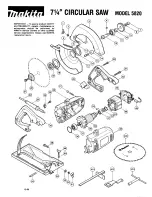
26
27
26
27
clamp and get a solid grasp on.
Plan the way you will grasp the
workpiece from start to finish. Avoid
awkward operations and hand
positions. A sudden slip could cause
your fingers or hand to move into
the blade.
DO NOT OVER-REACH
Keep good footing and balance. Keep
your face and body to one side, out of
the line of a possible kickback. NEVER
stand in the line of the blade.
Never cut freehand:
●
Brace your workpiece firmly against
the fence and table stop so it will not
rock or twist during the cut.
●
Make sure there is no debris
between the workpiece and the table
or fence.
●
Make sure there are no gaps
between the workpiece, fence and
table that will let the workpiece shift
after it is cut.
●
Keep the cut off piece free to move
sideways after it is cut off. Otherwise,
it could get wedged against the
blade and thrown violently.
●
Only the workpiece should be on the
saw table.
●
Secure work. Use clamps or a vise
to help hold the work when it’s
practical.
USE EXTRA CAUTION WITH LARGE
OR ODD SHAPED WORKPIECES.
●
Use extra supports (tables,
sawhorses, blocks, etc.) for
workpieces large enough to tip.
●
Never use another person as a
substitute for a table extension, or as
an additional support for a workpiece
that is longer or wider than the basic
miter saw table, or to help feed,
support, or pull the workpiece.
●
Do not use this saw to cut small
pieces. If the workpiece being cut
would cause your hand or fingers to
be within 6 inches of the saw blade
the workpiece is too small. Keep
hands and fingers out of the “no
hands zone” area marked on the
saw table.
●
When cutting odd shaped
workpieces, plan your work so it
will not bind in the blade and cause
possible injury. Molding, for example,
must lie flat or be held by a fixture or
jig that will not let it move when cut.
●
Properly support round material such
as dowel rods, or tubing, which have
a tendency to roll when cut, causing
the blade to “bite”.
To avoid injury, follow all applicable
safety instructions, when cutting
non-ferrous metals:
●
Use only saw blades specifically
recommended for non-ferrous
metal cutting.
●
Do not cut metal workpieces that must
be hand held. Clamp workpieces
securely.
●
Cut non-ferrous metals only if you
are under the supervision of an
experienced person and the dust
bag has been removed from
the saw.
WHEN SAW IS RUNNING
Do not allow familiarity from
frequent use of your miter saw
to result in a careless mistake.
A careless fraction of a second is
enough to cause a severe injury.
Before cutting, if the saw makes an
unfamiliar noise or vibrates, stop
immediately. Turn the saw OFF.
Unplug the saw. Do not restart until
finding and correcting the problem.
WARNING
!
WARNING
!
















































